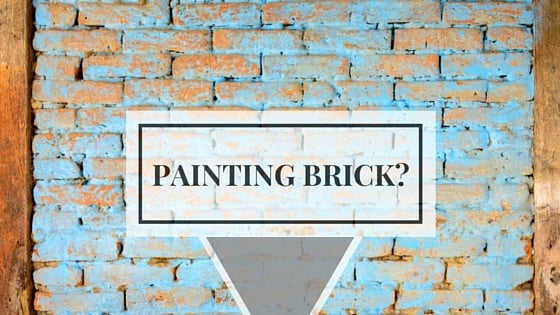
Painting brick masonry may seem quite straightforward. However, your success or failure will depend on how well you prepare the surface.
As with any other painting project, there are a few do’s and don’ts a DIYer should be aware of to obtain the results expected and enjoy a long-lasting brick paint job. To offer you valuable advice, we talked to our professional Florida painters to get their take on surface preparation prior to painting brick masonry.
New Masonry
As a general rule, new brick masonry doesn’t require painting. But because brick is a porous material that can absorb rain water and moisture from the air, sealing or painting brick is advisable in the humid climate of Florida. To properly prepare brick masonry for painting, you should wash wall surfaces with a zinc-sulfate or zinc-chlorine solution to neutralize the alkalis (soluble mineral salts) that may be present into the brickwork and reduce the risk of alkali-caused paint failures. Under no circumstances should acid cleaning solutions be used to clean brick walls, as acid reactions can lead to early paint failure.
Old Unpainted Masonry
Before painting old brick masonry, inspect all the surfaces for evidence of water stains, mildew, mold, moss and efflorescence. This can help you spot a variety of underlying issues that will ultimately escalate into more serious problems. As an example, water stains, mildew and mold growth can suggest ongoing water leaks, whereas efflorescence may indicate the probable presence of alkalis, which will eventually cause paint deterioration. After identifying and solving underlying issues like cracks, holes, roof leaks, burst water pipes, condensation within walls, etc., select the gentlest effective cleaning method for your masonry. If you use a cleaning solution, saturate the wall with water beforehand and apply the solution without overlapping the adjacent areas being cleaned. Then, rinse the newly cleaned areas thoroughly with fresh water.
Painted Masonry
Previously painted brick surfaces often require extensive prep work, especially in humid climates. If mold is present, use a soft brush and a chlorine solution, a trisodium phosphate solution or a mixture of 1 ounce of detergent, 3 ounces of trisodium phosphate, 30 ounces of 5-percent sodium hypochlorite and 100 ounces of warm water to wash away mold and dirt. As soon as the surface is clean, rinse it with water. If the paint film is cracked or peels off, remove the entire finish, brush and rinse the surface with water. Find and fix the underlying causes behind paint failure before applying a new coat of paint.
Why You Should Prime Brick Surfaces
Irrespective of the cleaning method used to prepare brick for painting, always apply a good quality, specialty primer as soon as the wall surface has dried completely. The primer will make the new coat of paint bond tightly to the substrate, which will increase the performance characteristics and durability of the paint system.
Specifically formulated to seal brick and prevent topcoats from being attacked by the free alkalis that may be present in brick masonry, alkali-resistant primers are the best products you can use prior to painting brick. Besides improving the performance and service life of paint systems, alkali-resistant primers protect wall structures from the elements, including intense UV radiation, high temperatures, elevated moisture levels and wind-driven rain, and guard against efflorescence and stains caused by smoke, tannins and ink.
Whether you add one or several coats of primer, let each coat dry completely before going any further. Then, paint the surface using a regular acrylic-latex, elastomeric or alkali-resistant paint. Once painted, brick masonry should be repainted every three to five years. If you want to preserve the original beauty and character of your brick structures, you can opt for brick sealers or water repellents instead of paint.
If you’re in Jacksonville or Tampa, FL, or surrounding areas and need help with your painting project, please don’t hesitate to contact us for a free consultation and quote. Whether the surfaces you want to paint are brick, stucco, concrete, plaster, drywall, wood or metal, our professional painters can help you turn your dull, tired-looking home into a bright and colorful work of art in just a few days.






